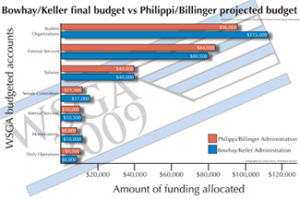WSGA under budget crunch
May 12, 2008
With the end of the Washburn Student Government Association’s fiscal year coming up this fall, Kevin Nincehelser, WSGA budget director, is seeing red.
Or at least he soon expects to.
With only $17,000 left in reserve funding and several other accounts under $5,000, Nincehelser is predicting that several accounts WSGA holds will go into the negative before the student activity fee is distributed in the fall. Primarily, this is because there are still expenses WSGA must take care of before receiving revenue from the activity fee.
As the student activity fee is the sole source of funding for WSGA, the amount of funding available is directly tied to the number of students enrolled at Washburn University. As of last fall, enrollment numbers had dropped 3.5 percent from the previous year. While funding available from the student activity fee was up more than $140,000, the fee was also raised from $21 to $43. Nincehelser said that he kept all these numbers in mind when putting together the current budget projection, which was approved last Wednesday by the senate.
WSGA has had to make several cuts to future funding in anticipation of the fall semester student activity fee funds. Most notably, the funds available for student organizations currently stand at $96,000, as opposed to $115,000 during the Bowhay/Keller Administration. Nincehelser, however, said that numbers on the projected budget could be somewhat misleading.
“The preliminary budget isn’t very important as far as we’re concerned,” said Nincehelser, citing that there was still much room for change between now and next fall.
Specifically, budgeted amounts were set low in anticipation of falling enrollment numbers.
Yet another reason Nincehelser wanted to keep initial numbers low was to keep from disappointing anyone when final allocations are announced next fall.
“Last year [the Bowhay/Keller administration] set the budget around $291,000,” said Nincehelser. “We tried to do the opposite this year.”
After setting high expectations last year, the Bowhay/Keller administration was forced to make severe cuts into their projected budget as available revenue from the student activity fee tallied $276,000, a full $15,000 lower than what they had expected.
The most important thing to remember, said Nincehelser, is any additional activity fee revenue received past the currently budgeted $261,000 will be put into the student organizations fund to help fill it up to the $115,000 cap. Past that point, it will then be put into the account to manage external projects and services, such as events like the lecture series, and will be allocated as needed.
“We’re really trying to tighten [the budget] down and use only what we need,” said Nincehelser. “Personally, I don’t like spending money we don’t have.”
Whitney Philippi, WSGA president, agreed with Nincehelser on the fact that the budget for this year is much tighter than in the past. Specifically, Philippi noted the budget crunch is something that is not just affecting WSGA, but the university as a whole.
When creating the budget for next year, Philippi and Nincehelser said they based numbers on expenditures in previous years and then trimmed from where they could. Initially, student organization funding was set at $80,000, but then $16,000 in cuts was made to raise the amount to where the projected amount currently stands.
“Honestly, we really didn’t have a whole lot of choice,” said Philippi in reference to where and how funding was cut and moved from one allocation to another.



